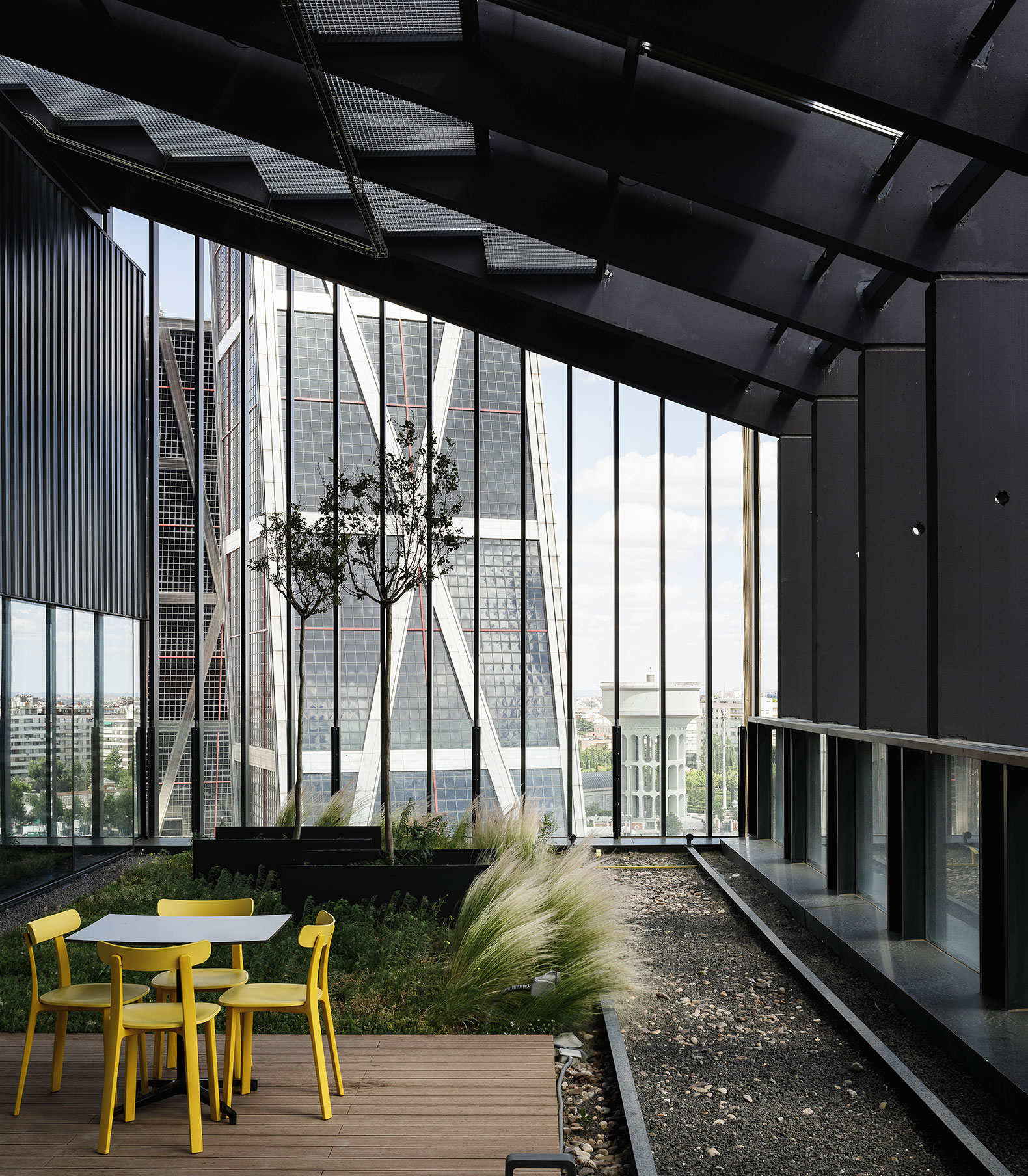The central garden has been built seeking to maintain the legacy of the old garages based on their existing structure and the movable elements that made it up, such as metal stairs, masts, and even the recovered tracks, located on one of the rooftops. The yellow colour has been chosen in relation to the previous identity of the building and because it is one of the characteristic colours of the Madrid Metro. And an old ballast deposit will mark the access to the garden and announce the treasures of the railway that the park will host.

Metro de Madrid Headquarters and Transport Complex by Nexo + Gutiérrez-delaFuente + Perea. Photograph by Fernando Alda.
The building follows the nZEB principles of almost zero energy consumption (it has 56 geothermal wells and 512 photovoltaic solar modules that help reduce the building's electricity consumption). Inside, the air conditioning works with a mesh of cold beams, housed in the vaults of the prefabricated T-beams. Outside, the roofs are open with a series of inclined frames that are reminiscent of the structures of the industrial buildings of the old warehouse, now house gardens and old pathways.
The new Madrid Metro Headquarters is the first part of the CIT built. This building would be joined in a later phase by the CCOR (New Command Post and COMMIT), the Regional Transport Consortium, and the Transport Museum.

Metro de Madrid Headquarters and Transport Complex by Nexo + Gutiérrez-delaFuente + Perea. Photograph by Fernando Alda.

Metro de Madrid Headquarters and Transport Complex by Nexo + Gutiérrez-delaFuente + Perea. Photograph by Fernando Alda.
Description of project by Nexo Arquitectura, Gutiérrez-delaFuente Arquitectos and Andrés Perea Arquitecto
Metro de Madrid Transport Complex (CIT): an institutional campus
The CIT is an initiative by Metro de Madrid to build a Transport Campus on the site of Plaza Castilla (Avenida de Asturias) where the former depots of Line 1 were located. The project has a double objective, on one side the urban regeneration through an existing plot, containing an obsolete Metro facility, and on the other hand the centralization of office spaces and services related to transport in the Community of Madrid and to the already centennial Metro de Madrid.
The new headquarters of Metro de Madrid company are completed (in 2022) as the first component of the Campus (Phase 01).
The CCOR (New Technological and Operational Center), a building for the Regional Transport Consortium and the Museum of Transport will be included in a second phase. All the buildings are framed within the sustainability criteria and the almost zero consumption building standards nZEB.
A new urban acropolis: Metro de Madrid making city
One of the urban projects key, belonging to this institutional acropolis, is the visual and physical permeability which allows the visitor to articulate the relationship between the built, the central garden and the urban context. A new urban structure clarifies the space of the street and the interior Garden. A new habitat for the workers, the neighbours, and the visitors but also for the local fauna and flora. The CIT creates a space which Madrileños would remember, a space they would want to come to and feel like citizens. A place that does not exist in the environment of Plaza Castilla. Just yet.

Metro de Madrid Headquarters and Transport Complex by Nexo + Gutiérrez-delaFuente + Perea. Photograph by Fernando Alda.
Metro de Madrid legacy: a heritage for the future
The central Garden, Jardín 1 Metro (in regard to the old depots of the Metro Line 1) is a new Metro park which maintains the legacy of the old depot space. A new space that talks about the infrastructures that made Madrid a great city, and which reflect a contemporary attitude to restore, update and reuse. A contemporary urban archaeology practice based on a circular strategy.
The past of this place will be present in numerous aspects, but it gets its particular importance in the central Garden, built from the depot's existing structure and the ”furniture” elements such as the escalators, the mechanical doors, the masts, the railways and many others, keeping their yellow colour of maximum visibility, considered very iconic in the industrial Metro culture. Attention should also be drawn to the recycling of the ballast deposit, still on the plot, which will be an urban landmark for the main access to the Garden.
The heritage of the place is renaturated and serves up as inspiration. It arises a hybrid landscape in Plaza de Castilla: Jardín-1.























































































